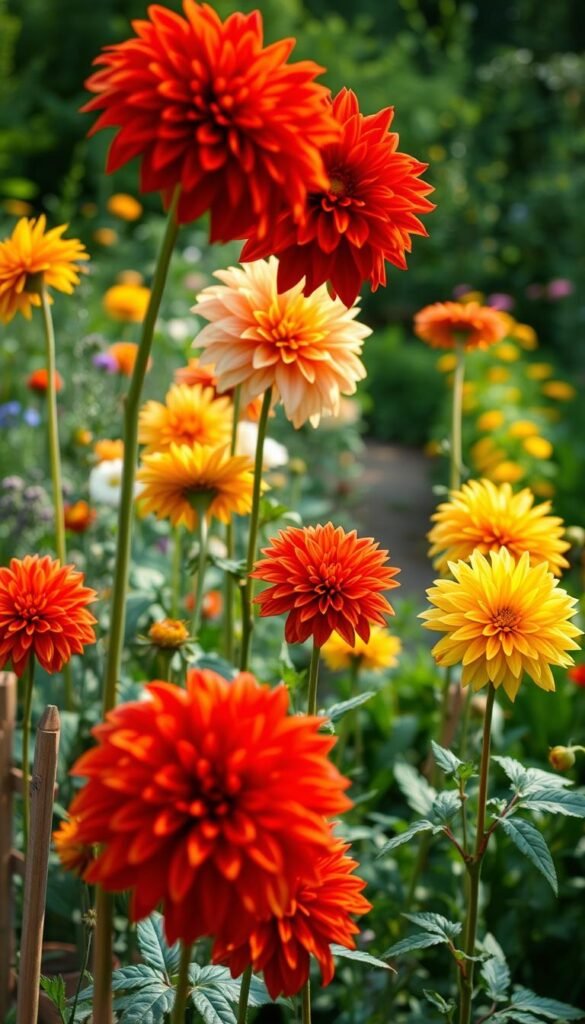Imagine stepping into a kaleidoscope of color where every stem bursts with blooms that dazzle from midsummer through fall. Dahlias deliver exactly that—fiery reds, buttery yellows, and every hue in between, shaped like starbursts, pom-poms, or delicate waterlilies. These showstoppers aren’t just pretty faces; they’re prolastic bloomers that reward careful attention with armfuls of fresh-cut flowers.
Native to Mexico’s highlands, these plants thrive in sunny spots and become the stars of late-season gardens. While they’re not fussy about soil, they demand three things: support to stand tall, consistent moisture, and regular grooming. Get these right, and you’ll enjoy hundreds of blossoms from just one tuber—enough to fill vases and share with friends.
This guide reveals the secrets to maximizing your dahlia’s potential. You’ll learn how to prevent snapped stems during summer storms, encourage deeper roots with smart hydration, and keep buds coming until frost. Whether you’re growing petite border varieties or dinner-plate giants, these techniques ensure your efforts bloom into success.
Understanding Your Dahlia Garden
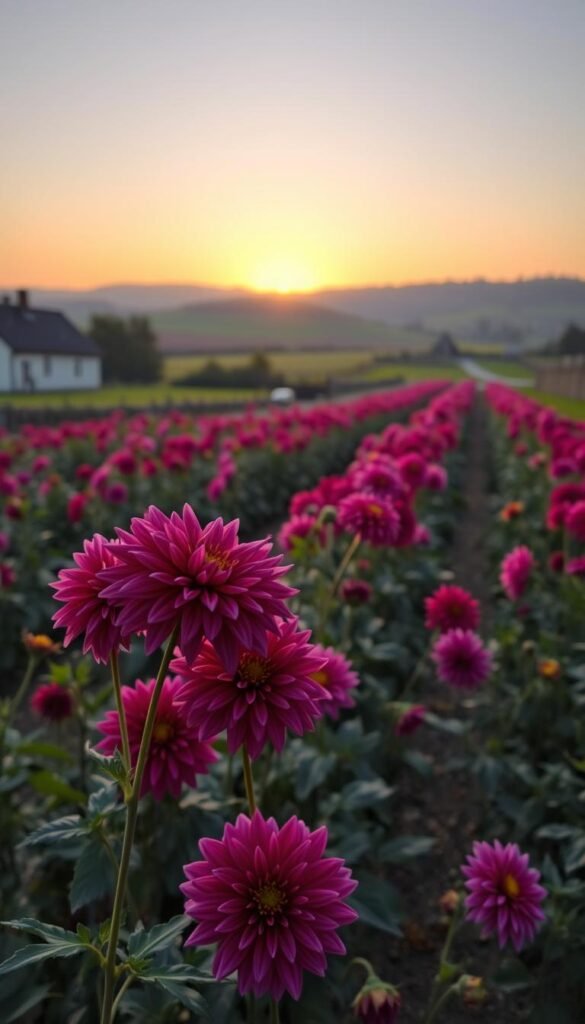
Dahlias carry a story as vibrant as their petals. These Mexican natives first nourished Aztec communities before Spanish explorers brought their tubers to Europe in the 1500s. What began as a food crop transformed into horticultural royalty, with over 50,000 registered varieties today.
Your garden hosts tender perennials that crave warmth like their mountain homeland. Unlike hardy plants, dahlias demand frost-free soil and 6-8 hours of daily sun. One early cold snap can end their show—so timing matters when planting or storing tubers.
Consider these key traits when growing dahlias:
- Tree varieties stretch taller than a giraffe, while compact types fit patio pots
- Complex blooms often lack nectar, making them less pollinator-friendly
- Each tuber behaves like a battery, storing energy for next season’s growth
“The dahlia’s journey from Aztec fields to Victorian gardens proves beauty often starts with utility.”
Whether you’re growing dahlias for cutting or curb appeal, remember: their needs shift with size. Dinnerplate varieties might need staking by July, while dwarf types stand strong on their own. Your climate plays director—warmer zones can leave tubers in ground, while northern gardeners become wintertime storage experts.
Selecting the Right Dahlia Varieties
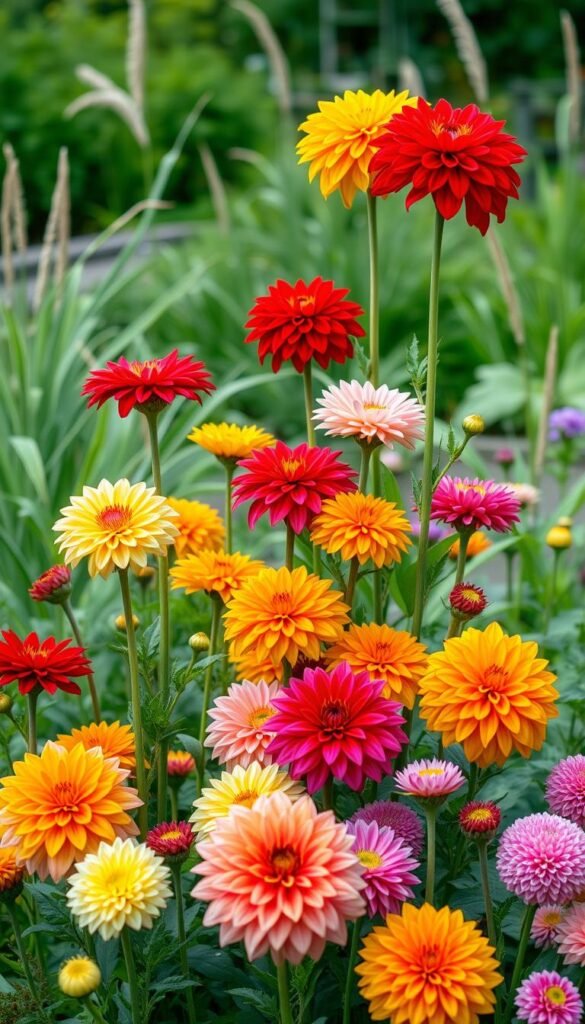
Your dahlia garden’s success starts with smart variety choices. With thousands of options available, you’ll want to match flower forms and plant size to your space and goals. Let’s explore how different types perform in cutting gardens and mixed borders.
Single vs. Double-Flowered Dahlias
Single varieties like ‘Bishop of Llandaff’ and ‘Joe Swift’ feature one layer of petals around a visible center. These dahlia plants attract pollinators while offering bold color. Double blooms like pompons create lush visual impact but often lack nectar access for bees.
| Type | Petal Structure | Benefits | Best For |
|---|---|---|---|
| Single | 1-2 rows | Pollinator-friendly | Wildlife gardens |
| Double | Multiple layers | Dramatic displays | Cut arrangements |
Exploring Dwarf and Tall Varieties
Compact types under 16 inches thrive in containers, while towering varieties over 5 feet need sturdy stakes. Dwarf dahlias like ‘Roxy’ work well in small spaces, whereas dinnerplate giants demand room to shine. Consider these options:
- Container stars: 12-24″ plants with medium blooms
- Border fillers: 3-4 foot varieties like cactus types
- Statement makers: 5+ foot plants with 10″ flowers
For a curated list of top performers, explore these must-grow dahlia varieties. Mix heights and bloom times to create continuous color from July through October.
Preparing Your Garden for Dahlia Planting
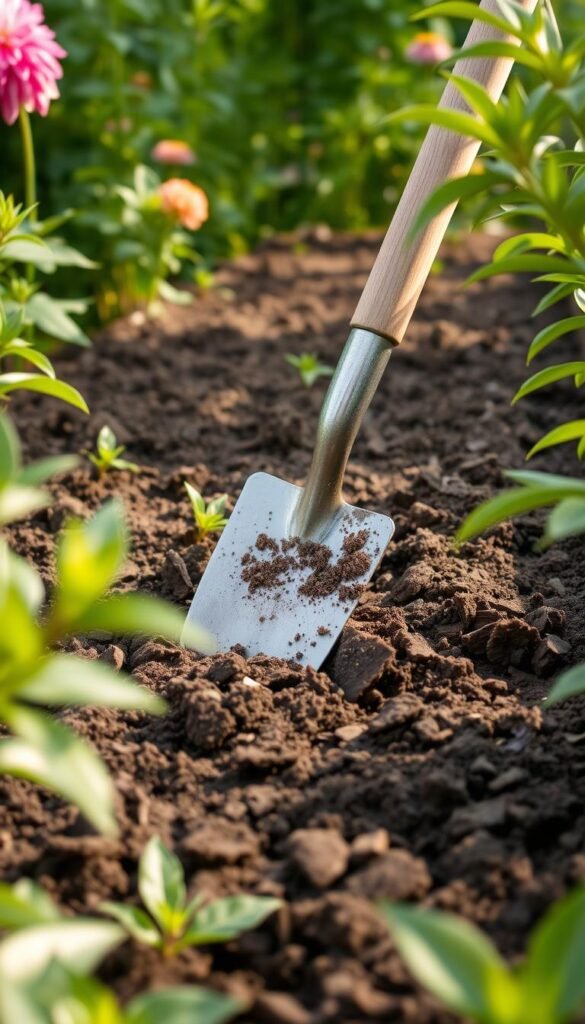
Great dahlia gardens begin long before the first tuber goes into the ground. Your soil’s texture and nutrients determine whether plants merely survive or explode with blooms. Start this process 3-4 weeks before planting dahlia tubers to let amendments fully integrate.
Soil Preparation and Organic Amendments
Dahlias demand soil that’s rich yet drains like a sieve. Mix 2-3 inches of compost into your entire bed, then focus on individual planting holes. Dig each 12 inches deep and 30cm in diameter—roughly the size of a basketball. This space lets roots spread without competition.
Fill the bottom third with aged manure or leaf mold. “Think of it as a nutrient buffet for your tuber,” says one grower. If your ground feels sticky, toss a handful of gravel into the hole to prevent waterlogging. Space holes 60cm apart—crowded plants attract pests and diseases.
Clay-heavy gardens need extra love. Blend equal parts sand and compost into excavated dirt before backfilling. Sandy soils? Add peat moss to retain moisture. Either way, let the prepared bed rest for 2 weeks. This waiting period lets microbes break down organic matter into plant-ready food.
Remember: skimping on soil prep means fewer flowers. Those who invest time here reap armloads of blooms all season.
Planting Dahlia Tubers for a Vibrant Garden
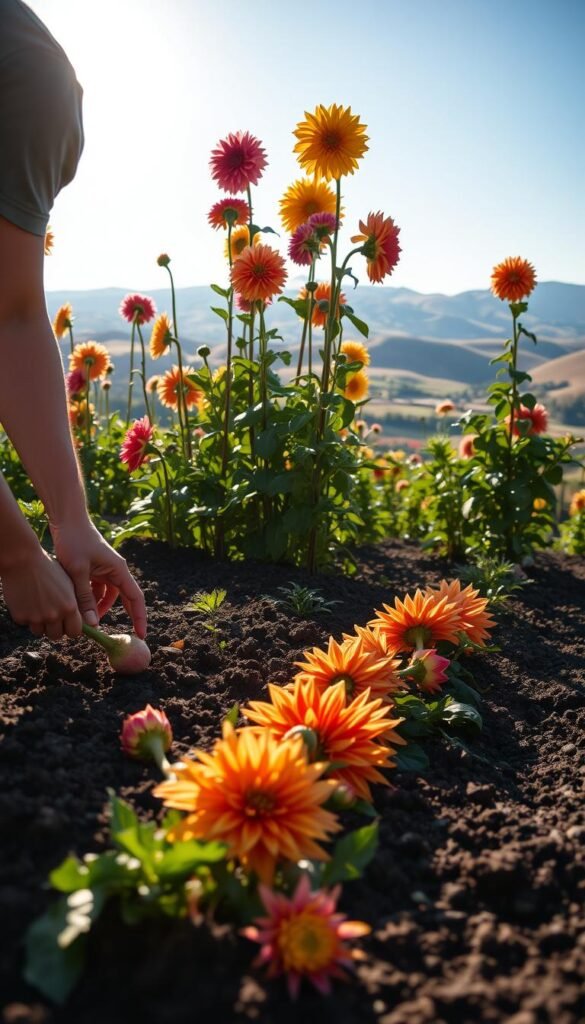
Timing transforms timid tubers into floral fireworks. These underground powerhouses need warmth to awaken – plant too early, and frost nips their progress. Wait until soil hits 60°F, typically when apple trees finish blooming in spring.
Start indoors 6-8 weeks before your last frost date. Place dahlia tubers horizontally in shallow trays filled with potting mix. The eye (looks like a tiny bump) should face upward. Cover with just enough soil to hide them – like tucking in a child.
Outdoor planting demands patience. Wait until all frost danger passes – usually mid-May in USDA zones 5-6. Dig holes 12 inches deep, mixing compost into the base. Space plants 30 inches apart for airflow. Here’s how indoor and outdoor methods compare:
| Method | Planting Time | First Blooms | Spacing |
|---|---|---|---|
| Indoor Start | Early April | Early July | 18″ pots |
| Direct Soil | Late May | Mid-August | 30″ beds |
Bury outdoor tubers 2 inches deep initially. As shoots emerge, gradually fill the hole. This “hilling” technique strengthens stems and prevents rot. Water lightly after planting – soggy soil drowns dormant roots.
Northern gardeners gain 4-6 weeks of extra bloom time by starting dahlias indoors. Southern growers can often plant directly after spring rains taper off. Either way, that first summer bloom makes the wait worthwhile.
Caring for a Dahlia-Filled Cut Flower Garden: Staking, Watering, and Deadheading
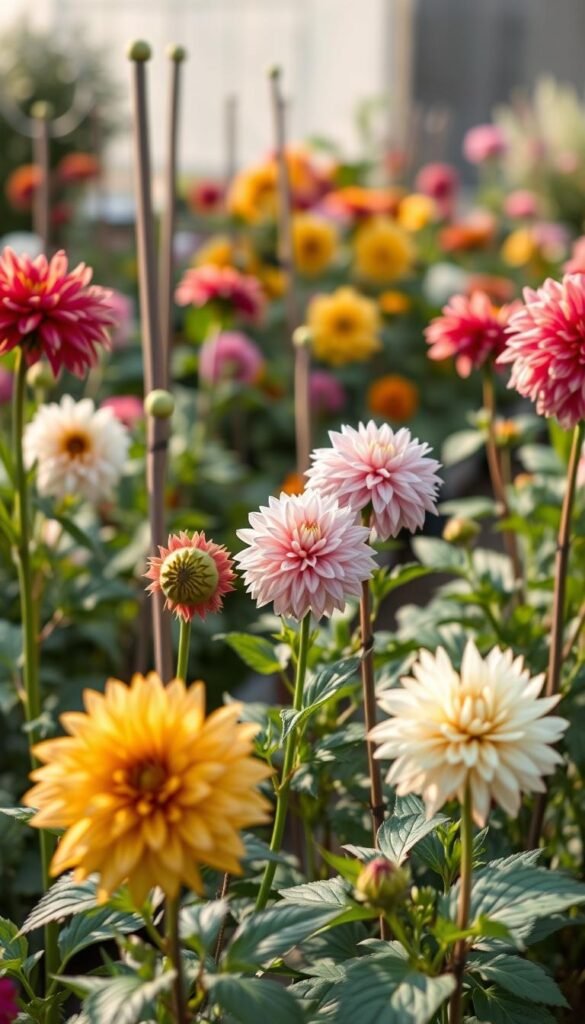
Transform your backyard into a floral powerhouse with three simple routines. Proper support, hydration, and grooming turn dahlia plants into nonstop bloomers. These techniques work like clockwork – nail them, and you’ll harvest armloads of cut flowers all summer long.
Start by installing stakes when plants reach 12 inches tall. Soft ties prevent wind damage while letting stems thicken naturally. Growing dahlias for arrangements? Use tomato cages for bushy varieties – they’ll produce twice as many usable stems.
Water deeply three times weekly, targeting the roots. Morning sessions reduce evaporation and disease risks. “Consistency matters more than quantity,” notes a Montana grower. “Drought-stressed plants drop buds faster than you can say ‘wilting!’”
Snip spent blooms every 3-4 days to trigger new buds. This practice:
- Extends flowering by 6-8 weeks
- Prevents energy waste on seed production
- Keeps plants compact and manageable
Follow this guide, and each tuber can pump out 100+ flowers. Fresh-cut stems last over a week in vases if harvested at the right stage. Pro tip: Cut when blooms are ¾ open for maximum vase life.
Expert Tips on Watering and Fertilizing Dahlias
Mastering moisture and nutrients unlocks your dahlias’ full potential. These heavy feeders thrive when you balance hydration with smart nutrition—a dance that keeps blooms coming and roots reaching deep. Let’s dive into practices that turn good growth into greatness.
Optimizing Your Watering Routine
Drench your dahlias weekly until water pools briefly on the soil. This soak-and-dry cycle encourages roots to dig deeper, building drought resilience. Use a moisture meter or finger test: aim for dampness 8 inches down, not surface wetness.
Container-grown dahlias play by different rules. Check pots daily in heat waves—they dry out faster than garden beds. Morning watering reduces evaporation, giving plants all day to drink.
Boost blooms with liquid seaweed or comfrey tea every 14 days. These natural fertilizers deliver potassium without harsh chemicals. For busy gardeners, slow-release pellets mixed into soil at planting time feed plants steadily for months.
Remember: healthy dahlias start with what’s beneath the petals. Nourish the ground, and your flowers will return the favor tenfold.

